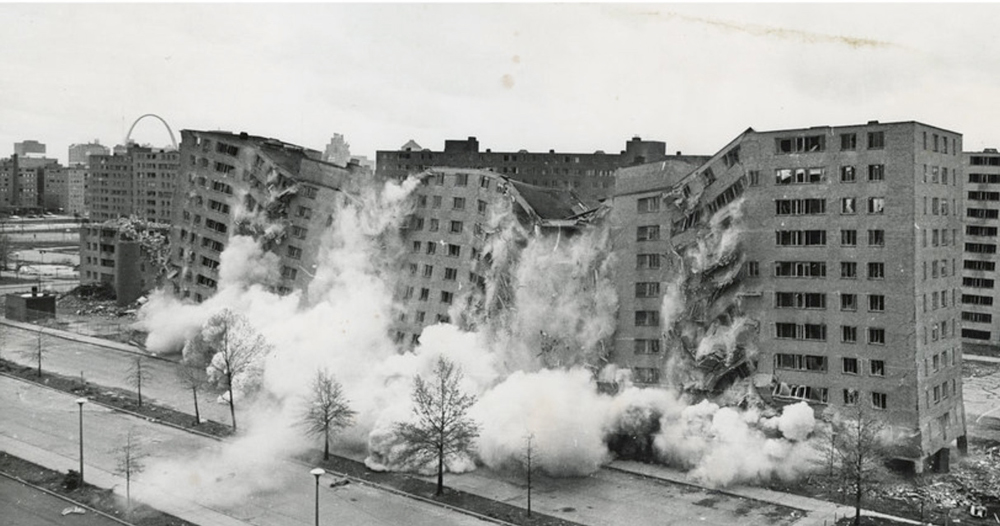By Chlotrudis Independent Film Society
Rating: 3 cats
Director: Chad Freidrichs

Country: united_states
Year: 2012
Running time: 79
IMDB: http://www.imdb.com/title/tt1788461/
Bruce says: “Minoru Yamasaki holds a distinction that no other architect will probably ever match. Two of his most famous projects were blown up – The World Trade Center in New York City, by terrorists and the Pruitt-Igoe projects in St. Louis, by the same governing body that commissioned them. Built in the early 50s, Pruitt-Igoe opened doors in its 33 buildings to roughly 12,000 residents in 1954. Now considered by many naysayers as proof that large scale urban projects are doomed to failure, the film examines those charges and delves into details and truths that are little understood and rarely publicized.
“The film uses great archival footage (including the iconic footage of the demolition of the projects) interspersed with talking heads that include former Pruitt-Igoe residents and professionals from various areas of expertise. To build the projects the City of St. Louis struck a bargain for developers to clear many of the city’s slum dwellings in desirable locations around the city and relocate the residents to Pruitt-Igoe built on 57 acres near downtown. Already St. Louis was experiencing population decline as the middle class migrated to the suburbs. City planners ignored the fact that the tax base was eroding as they foolishly thought that once occupied, rents from Pruitt-Igoe would pay handsomely for its upkeep. Within a few years, many residents had no money for rent. There was no money for maintenance. Garbage collection was infrequent, broken elevators remained unrepaired, power outages were plentiful, and crime became severe. Vandalism was rampant; little effort was made to vandal-proof any part of the projects. In 1969 a rent strike garnered national attention.
“The city also established punitive rules with undertones of morality. The city said, ‘we’re giving you money – we want to
control you,’ is the way one former resident puts it. Inspectors routinely checked apartments for live-in males and removed them even if they were working or were fathers of children in the apartment. Authorities ignored situations where twelve people shared three rooms and the mother slept in the kitchen. Many of the former Pruitt-Igoe residents recall wonderful times and a sense of community. This group feels the good outweighed the bad. Many tell of the excitement of moving from places that had no electricity or working plumbing into what was luxury housing. At the beginning everything was clean. Maintenance men were always sweeping; elevators were padded to prevent damage when residents moved in or out. By the 70’s, however, plumbing repairs were not made, raw sewage became a problem and long periods without heat became the norm. Broken windows went unreplaced. Rape was ever-threatening. The projects were stigmatized by crime. In 1972 the first three buildings were dynamited and the entire 57 acres was cleared by 1976. The area remains vacant almost forty years later.
“The New York Times recently published an article comparing Pruitt-Igoe to Penn South, the large complex built for the garment workers just south of Penn Station in Manhattan. Such comparisons, while fun, provide little insight. One set of housing projects was built for the working class, the other for non-working poor.
“What is in the film is more than adequate for understanding the specifics related to Pruitt-Igoe. What is missing is the big
picture. THE PRUITT-IGOE MYTH does very little to provide testimony from city planners, sociologists, welfare experts, or
academia. Whether the lack of a greater understanding of urban issues is the result of budget restrictions, filmmaker limitations or both is unclear. 3 cats”
